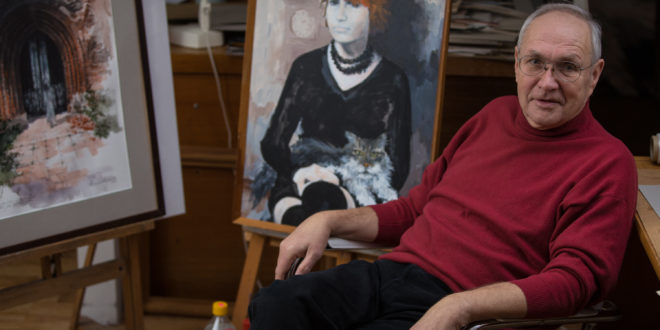By Kazys Almenas.
The watercolors of Romanas Borisovas are beautiful. Works of art do not require any additional justification. However, I am certain that after viewing them, many will experience something more. Let’s call it the breath of passing history, or possibly an intimation of the vulnerability of the works of man. The watercolors were painted during the past several decades; the destructive effect of time and history is their unifying thread. They cover a period when cataclysmic change swept over East Prussia, a time when the cultural heritage of an entire historical era was being mercilessly destroyed, and when a totally different historical reality was to be built on its ruins.
The setting for Borisovas’ paintings is a unique corner of Europe, which for a long time was called East Prussia. Periodically glaciers advanced over this territory from the heights of Scandinavia. The marks left by these geological events can be seen clearly on the western shore of the Semba peninsula (just to the east of present-day Kaliningrad or Karaliaučiai), where the rolling hills of Semba meet the Baltic Sea. It is not a gentle meeting; there is no beach; the waves hurl their full force directly against the hills that impede their progress. Looking down their remarkably stable sheer faces, one can see the history of this land, stretching back for many millions of years. Layers of gravel created by the debris of melted glaciers are separated by layers of sand, which mark millions of years when oceans covered the land. Down at the bottom, almost at the level where the waves beat against the precipitous face of the shoreside hills, there is a dark, tarlike layer, the remains from when the climate here was tropical and enormous conifer forests covered the region. It is this layer that has left a unique gift to this land. The sap that oozed from those trees became fossilized and the sea washed segments of it onto the beach, giving the region its name – “The Amber Shore.”
The glaciers of the last ice age melted about 12,000 years ago, a mere blink of the eye on the geological scale; human settlement followed not long thereafter. Evidence of the first Neolithic settlers is present from about 6,000 years ago, and thus antedates the pyramids of Egypt. Archeological evidence shows that the inhabitants were Balts. They evolved here through Neolithic times, to the Bronze, and subsequently, to the Iron Age. They had amber to trade, and did so with Greece, Rome, and Byzantium. After the Roman Empire collapsed and entire nations moved across the face of Europe, the Prussian Balts did not join the wandering throngs. Their neighbors, the Goths and the Galinds, moved; Slavs appeared in their stead. But the Baltic tribes remained where they had first settled. They cleared a part of the extensive forests and engaged in agriculture and fishery, and became artisans and tradesmen.
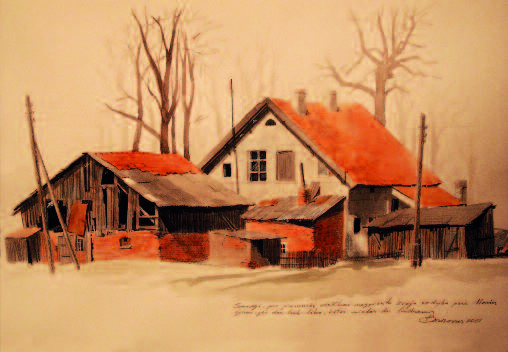
The glacier-swept land they inherited was not a wilderness anymore; it became desirable and attracted the attention of its neighbors. The Balts built numerous hill forts to defend their territory. It is at this point that written history begins. About 1,000 years ago, missionary Christianity reached the Baltic lands. The first meeting was not successful. Their neighbors, the Slavs and the Germanic peoples, had converted to Christianity a century or so earlier, but the Baltic tribes, including the Prussians, could not be persuaded. An additional two hundred years passed. Enormous changes occurred in Christian Europe during that time. Under the influence of the Crusades to the Holy Land, the teachings of Christ, the Prince of Peace, had become subverted. Christianity deformed into a war-like religion; the teachings of Christ were now spread by the sword. In fact, spreading of Christianity was just a façade; actually, the movement of Christian armies to the north was motivated by the knowledge that here lands could be won and held.
The following two centuries were bloody. In 1233 the Teutonic knights, an order of armed monks with origins in the Holy Land, transferred their base to Torun, Mazovia (a region in north central Poland, about 100 miles south of Gdansk), and, aided by volunteers from Christian Europe, began a war of conquest and conversion against the Prussian tribes. It took half a century to conquer the Prussians, then another 150 years during which the war was prosecuted less successfully against the Lithuanians. The numerous castles which dot the Prussian lands hark back to this time.
Until the Second World War this prolonged war dominated the historical consciousness of Prussia. This was due not only to the extraordinary length of this conflict, but also because in the medieval context, it was a clash of civilizations. The stakes were high – for the Baltic peoples, losing meant not just a change of religion but also servitude and acceptance of Germanic societal values and language. In the end the Lithuanians won and maintained much of their territory and most importantly, their identity, but the Prussians had to accept the lot of the conquered.
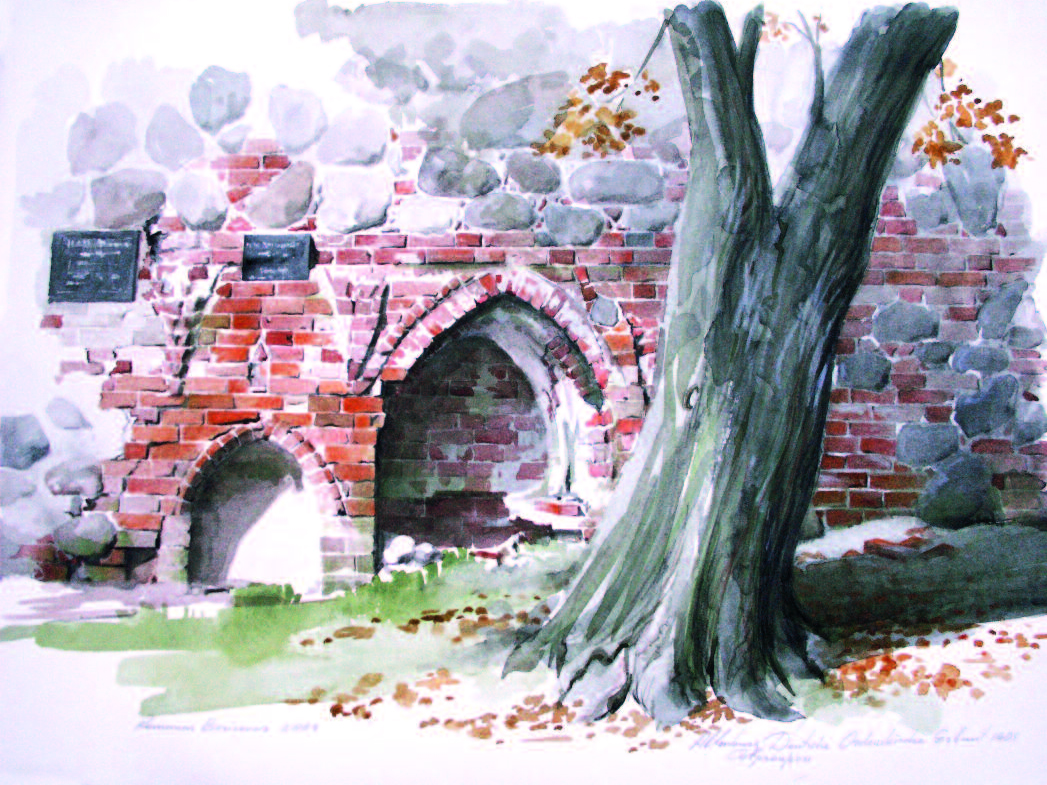
It took a long time for the conquerors and the conquered to meld into a new society. In conquered Prussia, the Prussian language survived for four hundred years, into the 17th century. In its northern segments Lithuanian was spoken well into the 20th century. Books were published in these languages, church services held. Baltic place-names survived in slightly Germanized versions; the legends, folk-tales, and songs of this region were a blend of local and German traditions. It is now apparent that the conquest was not a sudden destruction of the existing society, but a gradual, centuries-long coexistence and eventual blending of two peoples. As a result, a unique Prussian ethos developed.
Characteristics of the monarchical system and some unique historical accidents led to the ironic development that in the 16th century, “Prussia,” the name of the conquered people, was transferred to the region of Brandenburg (surrounding current-day Berlin), and later became synonymous with Germany. This changed the image of “Prussia,” and it was not a change for the better. It is well to remember that the inhabitants of the real Prussia were not responsible for the sins committed in their name during the 20th century by the government in Berlin.
Let’s return to the watercolors of Romanas Borisovas. They show the cultural heritage of the original Prussians only indirectly. It could not be otherwise. Prussian dwellings and hill fortifications were built of wood and vanished long ago. However, in choosing locations to be fortified, they chose well. The conquering Teutonic knights recognized this and built their own fortifications on the same sites. Usually they did not change the name of conquered territories, or changed them only slightly; thus Balga remained Balga, Ragainė was changed to Ragnit, and Šakiai to Schaaken.
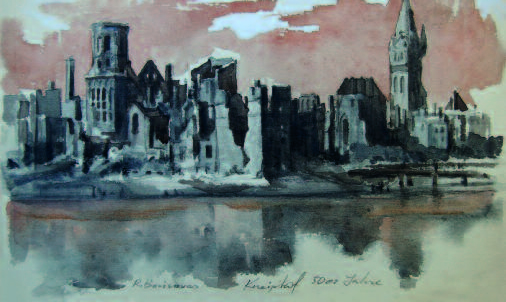
There is not much stone to be found in the glacierscraped land, so the builders of forts, churches, and castles used mostly bricks. This is evident in the watercolors of Borisovas. In most of the depicted structures, brick walls dominate. They show that medieval brick was not only a strong, but also an amazingly varied, building material. Borisovas reflects this variation in a truly masterful fashion. Note especially his paintings of structural elements like doorways and arches. The colors of the bricks vary from almost black, through various shades of red, to burnt yellow. That’s how they appear in reality. These were not factory-stamped bricks; each was formed individually by hand, dried in the sun and baked in wood-fired kilns. Subsequent centuries of sun, rain, and freezing weather altered their colors further. At the hands of a master painter, the subtle color variation of these bricks is represented beautifully.
Most of the structures depicted in the watercolors are ruins. Ruins of medieval castles do not dismay us. Openings in weathered massive walls, which allow a view into a stark interior, arches which support no roof, partially collapsed towers – all of that seems almost natural. Castles have long ago lost their function; their ruins mark the relentless passage of time. But look again. Many of the ruins documented in these watercolors are the remains of churches! Not only churches in the large towns which were bombed during the war, but in small villages, like Tarava, Lapynai, Pavandenė, and Obeliškiai, which survived the war intact. Borisovas recorded what he saw over several decades, thus the presented view is a glimpse not of what is, but what was. In the course of these decades, destruction proceeded apace, and some of the depicted church towers are now just piles of rubble.
That is the painful component of Borisovas’ work; it starkly shows us the changes that engulfed the Prussian land after 1945. The ruins of churches do not reflect the relentless, gradual action of time; they are evidence that a uniquely destructive historical shift engulfed this region. They show that no ties exist between the inhabitants who worshiped in these churches, some of them dating back to the 13th century, and the latest conquerors who replaced them. This time historical continuity was severed completely.
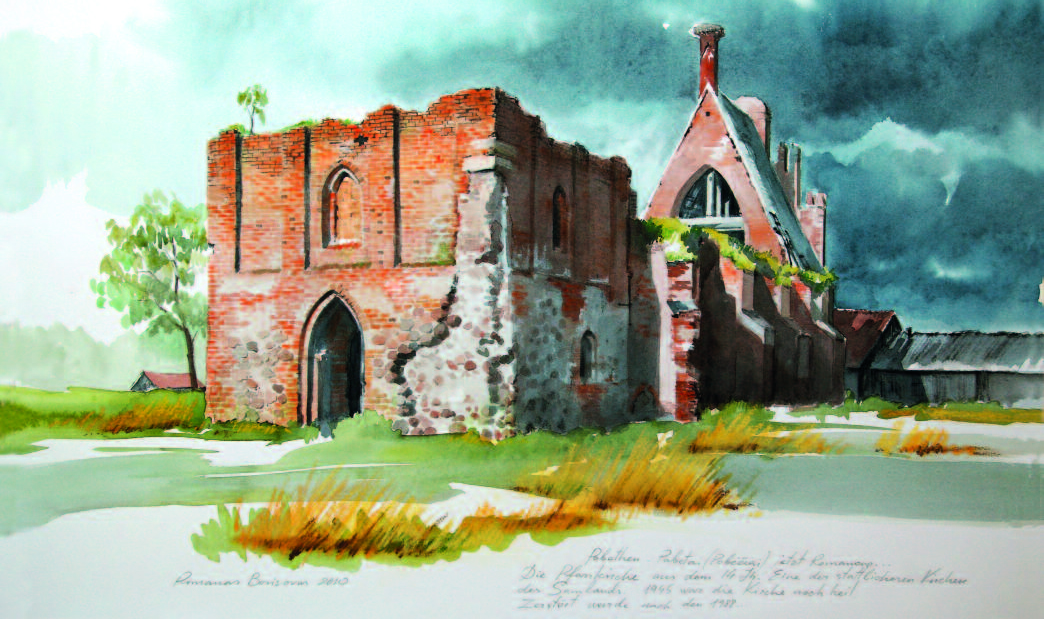
It is difficult to write about the fate of Prussia after 1945. The changes which took place there are so unique that it is difficult to find a point of comparison. There simply are no recognizable analogies. In 2003, after repeated visits to the region now called Kaliningrad (Karaliaučiai), I tried to summarize what I saw in an article titled “Consciousness Determines Reality.” An excerpt follows:
“It is ‘Kaliningrad’ not ‘Königsberg,’ which falls so much more gently on our ears. The historical city is gone, now there is just ‘Kaliningrad.’ I had to face this fact during my first visits here in the beginning of the 1990s. Not a trace was to be found of the old Königsberg. When I first visited this sad city, the ruins of the cathedral stood roofless, Lenin glared across the huge, concrete-paved ‘Victory’ square, surrounded by pompous, massive, colonnaded Soviet buildings. On the flat roofs of seemingly endless five- storied buildings of crumbling concrete, slogans such as ‘Slava Sovietskomu Narodu’ (Glory To the Soviet Nation) were spread out. The huge letters made of rusting iron matched the desolate gray, peeling facades of the buildings…
“The prime example of this ‘glory’ squatted right in the gutted heart of old Königsberg. There, at the location where Köningsberg’s landmark castle, the defensive, administrative, and cultural center of Prussia, had stood for 700 years, rose an uncompleted concrete monstrosity of unique ugliness. Try to imagine a twentystory high structure of bare gray concrete; rows of empty, glassless windows, and strange concrete protrusions. It squatted among piles of abandoned structural elements, garbage, and weeds, surrounded by a weathered wooden fence marred by scatological graffiti. Those who have seen the ‘Building of the Soviets’ know that my description of it is inadequate. Before giving up its ghost, the Soviet system built a monument to its impotence…
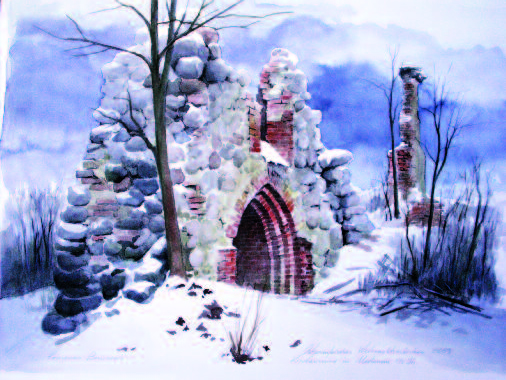
“It was still like that five years ago. At that time the first supermarkets had been built in Lithuania, pizza was replacing shashliks, and many facades of the Vilnius Old Town were gleaming with new paint. In comparison, Kaliningrad appeared even bleaker than during earlier visits. German funds were slowly restoring the cathedral, and the cleansed ancient brickwork contrasted with Soviet bleakness. Another change was a huge crater dug in a ramshackle park behind the statue of Lenin. A weathered billboard proclaimed that a cathedral was to be built in this place. At that time there was water at its bottom, trash floated on top of it, and Lenin did not seem overly concerned. So far, the evidence of capitalism around him consisted of numerous ramshackle kiosks…
“I noted that things had started to change during my 2003 visit when I reached the bridge across the Pregel River. From this position one had a good view of the blocks of concrete buildings which had been adorned with the huge rusting “Slava Sovietskomu Narodu” slogan. The slogan had now vanished! In its place, in somewhat smaller and considerably more elegant Latin, not Cyrillic, letters there was just one word – SAMSUNG.”
It is evident that changes are occurring. What will follow now? Lenin had cause to be worried. He is gone from Victory (formerly Hansa) square. In place of the crater behind his back there now rises a large Orthodox cathedral with five gold-plated domes. The generation which was born and grew up in this land does not harbor the destructive hate which their parents and grandparents brought with them. They are still very uncertain with regard to their identity, but many of them have developed a nostalgia for that which was destroyed. Pictures and mementos of old Köningsberg have become very popular, and some of the remaining structures in old Köningsberg have been restored.
The latest historical glacier which engulfed East Prussia in 1945 is melting, leaving enormous destruction and much debris behind. Like a block of hardening amber, the watercolors of Borisovas capture what happened to the cultural heritage of East Prussia. Even when the paintings depict evidence of barbaric destruction, they remain beautiful. That is the mark of the artist. However, the artist is free to choose what he will depict. Borisovas chose to depict the vanishing cultural heritage of Prussia and Königsberg. His accomplishment is not just the result of artistic talent, but also recognition of what is truly valuable. The technique is professional; it is the choice of subject matter that makes his work unique.
Adapted with permission from: “Disappearing East Prussia” (Išeinantys Rytprūsiai). Catalog for an Art Exhibition by Romanas Borisovas. Kaunas: Kopa, 2006. Watercolors can be purchased directly from the artist: romanas.borisovas@gmail.com.
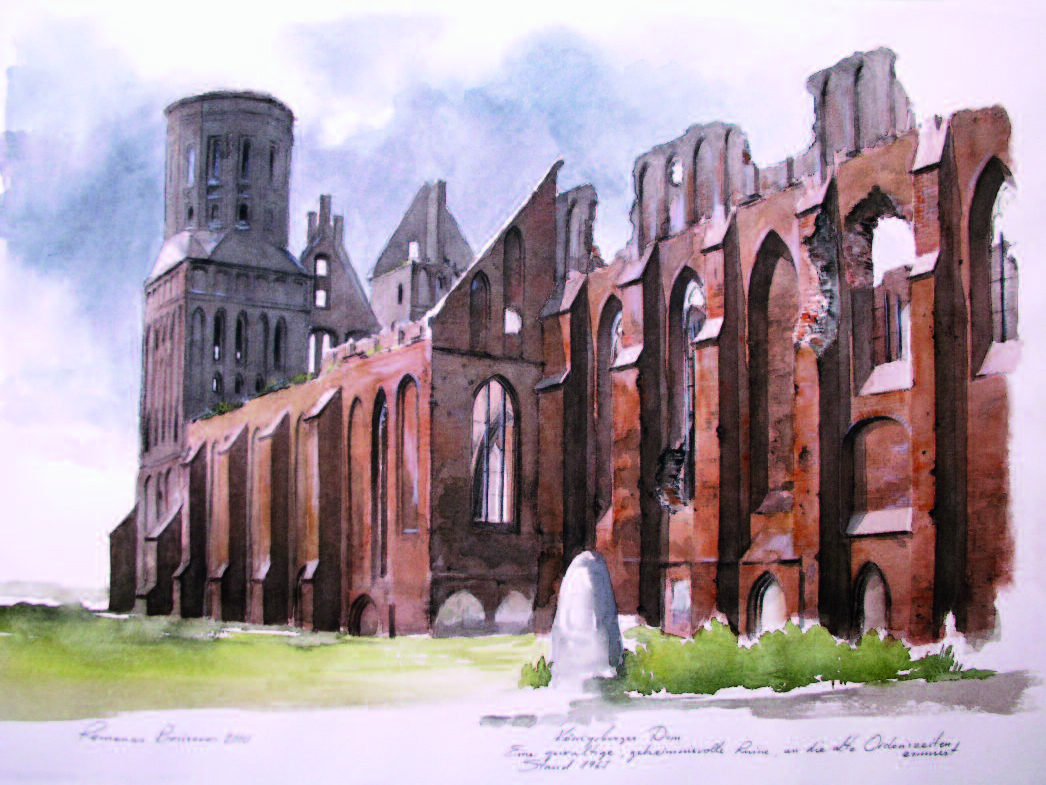
 DRAUGAS NEWS Lithuanian World Wide News in English
DRAUGAS NEWS Lithuanian World Wide News in English
